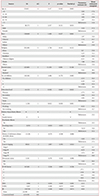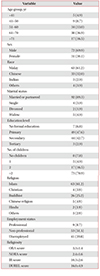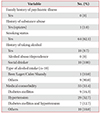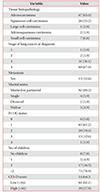1. Torre LA, Bray F, Siegel RL, Ferlay J, Lortet-Tieulent J, Jemal A. Global cancer statistics, 2012. CA Cancer J Clin. 2015; 65:87–108.

2. Molina JR, Adjei AA, Jett JR. Advances in chemotherapy of non-small cell lung cancer. Chest. 2006; 130:1211–1219.

3. Siegel RL, Miller KD, Jemal A. Cancer statistics, 2015. CA Cancer J Clin. 2015; 65:5–29.

4. Spiegel D. Cancer and depression. Br J Psychiatry Suppl. 1996; (30):109–116.

5. Walker J, Cassidy J, Sharpe M. SMaRT Oncology-3 Trialists. The third symptom management research trial in oncology (SMaRT oncology-3): a randomised trial to determine the efficacy of adding a complex intervention for major depressive disorder (depression care for people with lung cancer) to usual care, compared to usual care alone in patients with lung cancer. Trials. 2009; 10:92.

6. Hopwood P, Stephens RJ. Depression in patients with lung cancer: prevalence and risk factors derived from quality-of-life data. J Clin Oncol. 2000; 18:893–903.

7. Vilagut G, Forero CG, Barbaglia G, Alonso J. Screening for depression in the general population with the center for Epidemiologic Studies Depression (CES-D): a systematic review with meta-analysis. PLoS One. 2016; 11:e0155431.

8. Montazeri A, Gillis CR, McEwen J. Quality of life in patients with lung cancer: a review of literature from 1970 to 1995. Chest. 1998; 113:467–481.
9. Pinquart M, Duberstein PR. Depression and cancer mortality: a meta-analysis. Psychol Med. 2010; 40:1797–1810.

10. Pirl WF, Greer JA, Traeger L, Jackson V, Lennes IT, Gallagher ER, et al. Depression and survival in metastatic non-small-cell lung cancer: effects of early palliative care. J Clin Oncol. 2012; 30:1310–1315.

11. Spiegel D, Bloom JR, Kraemer HC, Gottheil E. Effect of psychosocial treatment on survival of patients with metastatic breast cancer. Lancet. 1989; 2:888–891.

12. Hann D, Winter K, Jacobsen P. Measurement of depressive symptoms in cancer patients: evaluation of the Center for Epidemiological Studies Depression Scale (CES-D). J Psychosom Res. 1999; 46:437–443.
13. Pirl WF, Temel JS, Billings A, Dahlin C, Jackson V, Prigerson HG, et al. Depression after diagnosis of advanced non-small cell lung cancer and survival: a pilot study. Psychosomatics. 2008; 49:218–224.

14. Koenig HG. Research on religion, spirituality, and mental health: a review. Can J Psychiatry. 2009; 54:283–291.

15. Koenig HG, Hays JC, George LK, Blazer DG, Larson DB, Landerman LR. Modeling the cross-sectional relationships between religion, physical health, social support, and depressive symptoms. Am J Geriatr Psychiatry. 1997; 5:131–144.

16. American Psychiatric Association. Guidelines regarding possible conflict between psychiatrists' religious commitment and psychiatric practice. Am J Psychiatry. 1990; 147:542.
17. Ginsburg ML, Quirt C, Ginsburg AD, MacKillop WJ. Psychiatric illness and psychosocial concerns of patients with newly diagnosed lung cancer. CMAJ. 1995; 152:701–708.
18. Koenig HG, Bussing A. The Duke University Religion Index (DUREL): a five-item measure for use in epidemological studies. Religions. 2010; 1:78–85.

19. Nurasikin MS, Aini A, Aida Syarinaz AA, Ng CG. Validity and reliability of the Malay version of Duke University Religion Index (DUREL-M) among a group of nursing student. Malays J Psychiatr. 2010; 19:MJP-02-12-10.
20. Wang J, Sun YL, Rong Y, Zhang YH, Wang ZZ. The reliability of Chinese version DUREL scale. J Ningxia Med Univ. 2013; 35:550–552.
21. Rodin D, Banihashemi B, Wang L, Lau A, Harris S, Levin W, et al. The Brain Metastases Symptom Checklist as a novel tool for symptom measurement in patients with brain metastases undergoing whole-brain radiotherapy. Curr Oncol. 2016; 23:e239–e247.

22. Shi Y, Gu F, Hou LL, Hu YQ. Self-reported depression among patients with non-small cell lung cancer. Thorac Cancer. 2015; 6:334–337.

23. Abhishekh HA, Balaji AL, Mehta RM. Depression in lung cancer patients. Indian J Psychiatry. 2014; 56:307.

24. Maneeton B, Maneeton N, Reungyos J, Intaprasert S, Leelarphat S, Thongprasert S. Prevalence and relationship between major depressive disorder and lung cancer: a cross-sectional study. Onco Targets Ther. 2014; 7:815–821.

25. Chen J, Li W, Cui L, Qian Y, Zhu Y, Gu H, et al. Chemotherapeutic response and prognosis among lung cancer patients with and without depression. J Cancer. 2015; 6:1121–1129.

26. Sullivan DR, Forsberg CW, Ganzini L, Au DH, Gould MK, Provenzale D, et al. Longitudinal changes in depression symptoms and survival among patients with lung cancer: a national cohort assessment. J Clin Oncol. 2016; 34:3984–3991.

27. Montazeri A, Milroy R, Hole D, McEwen J, Gillis CR. Anxiety and depression in patients with lung cancer before and after diagnosis: findings from a population in Glasgow, Scotland. J Epidemiol Community Health. 1998; 52:203–204.

28. Massie MJ. Prevalence of depression in patients with cancer. In : NIH State-of-the-Science Conference on Symptom Management in Cancer: Pain, Depression, and Fatigue; 2002 Jul 15–17; Bethesda, MD, USA.
29. Sullivan DR, Forsberg CW, Ganzini L, Au DH, Gould MK, Provenzale D, et al. Depression symptom trends and health domains among lung cancer patients in the CanCORS study. Lung Cancer. 2016; 100:102–109.

30. Vodermaier A, Linden W, Siu C. Screening for emotional distress in cancer patients: a systematic review of assessment instruments. J Natl Cancer Inst. 2009; 101:1464–1488.

31. Krebber AM, Buffart LM, Kleijn G, Riepma IC, de Bree R, Leemans CR, et al. Prevalence of depression in cancer patients: a meta-analysis of diagnostic interviews and self-report instruments. Psychooncology. 2014; 23:121–130.

32. Mystakidou K, Tsilika E, Parpa E, Katsouda E, Galanos A, Vlahos L. Assessment of anxiety and depression in advanced cancer patients and their relationship with quality of life. Qual Life Res. 2005; 14:1825–1833.

33. Kader Maideen SF, Sidik SM, Rampal L, Mukhtar F. Prevalence, associated factors and predictors of depression among adults in the community of Selangor, Malaysia. PLoS One. 2014; 9:e95395.

34. Rosenstein DL. Depression and end-of-life care for patients with cancer. Dialogues Clin Neurosci. 2011; 13:101–108.

35. McCullough ME, Larson DB. Religion and depression: a review of the literature. Twin Res. 1999; 2:126–136.

36. DiMatteo MR, Lepper HS, Croghan TW. Depression is a risk factor for noncompliance with medical treatment: meta-analysis of the effects of anxiety and depression on patient adherence. Arch Intern Med. 2000; 160:2101–2107.






 PDF
PDF ePub
ePub Citation
Citation Print
Print






 XML Download
XML Download